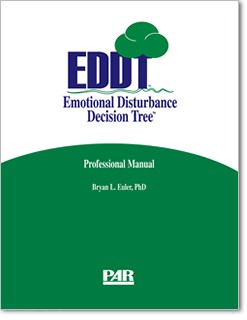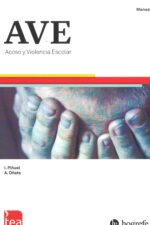Para más información de precio y gastos de envío,
favor enviar email con su información a
info@euroamericanapr.net
** Ciertas Restricciones Aplican **
- Purpose: Assesses emotional disturbance from the teacher’s perspective
- Format: Paper and pencil, Online administration and scoring via PARiConnect
- Age range: 5 years to 18 years
- Time: 15-20 minutes
The EDDT Multi-Rater Summary Report is also now available for FREE for a limited time. This report combines EDDT scores from up to four raters (parent, teacher, and self-report) to provide a well-rounded view of student functioning. It includes a combined score profile to represent similarities and differences between raters graphically and highlights statistically significant score differences. The EDDT Criteria Table aligns each rater’s scores to the federal criteria for ED diagnosis. To view a sample report, click the Resources tab above.
New white papers available! A white paper on identifying emotional disturbance using PAR products, including the EDDT, is now available. Click the Resources tab above or here to view or download. Supplemental material from Jenny A. Greene and EDDT author Bryan L. Euler explains how to use the EDDT family of rating forms to gain multiple perspectives. Click the Resources tab above or here to view or download.
The first instrument of its kind to provide a standardized approach to the assessment of emotional disturbance (ED), the EDDT encompasses all the federal criteria and addresses the broad emotional and behavioral nuances of children who may require special education services for ED.
Features and benefits
- From the U.S. Code of Federal Regulations (2002) and the reauthorization of IDEA (2004), the federal criteria mandate that certain conditions be present in order to receive services but don’t provide assessment guidelines. The EDDT includes five sections that correlate with the specific components of the federal criteria, enabling you to work through each criterion one by one.
- Because the criteria specify that socially maladjusted children can’t qualify for services unless they are both socially maladjusted and emotionally disturbed, the EDDT treats social maladjustment as a supplemental trait and assesses it separately from ED.
Test structure
- Emotional Disturbance Characteristics scales include Inability to Build or Maintain Relationships, Inappropriate Behaviors or Feelings, Pervasive Mood/Depression, and Physical Symptoms or Fears.
- Screening items are included within the Attention-Deficit Hyperactivity Disorder cluster and the Possible Psychosis/Schizophrenia cluster.
- The Level of Severity cluster and the Educational Impact cluster address how emotional and behavioral problems affect students and aid in the development of recommendations and interventions.
- Multi-Rater Summary Forms can be used in conjunction with the EDDT-PF and EDDT-SR to review responses from multiple raters over time to create a well-rounded picture of an individual’s functioning.
Technical information
- Norms are based on a sample of 601 children who were demographically matched to U.S. Census statistics. Data were also collected on a sample of 404 children eligible for special education due to an ED diagnosis.
- Internal consistency was high (r = .94) for the EDDT Total Score and ranged from .75 to .88 for the scales. In addition, test-retest stability was high (r = .92) and interrater reliability was good (r = .84) for the EDDT Total Score.
- Convergent validity was examined using the CAB™ Teacher and Parent Forms, the BASC-2 Teacher Form, and the Teacher Report Form of the CBCL. Validity also was examined in populations of children with specific learning disabilities, speech/language impairment, mental retardation, ADHD, autism spectrum disorder, and social maladjustment.












